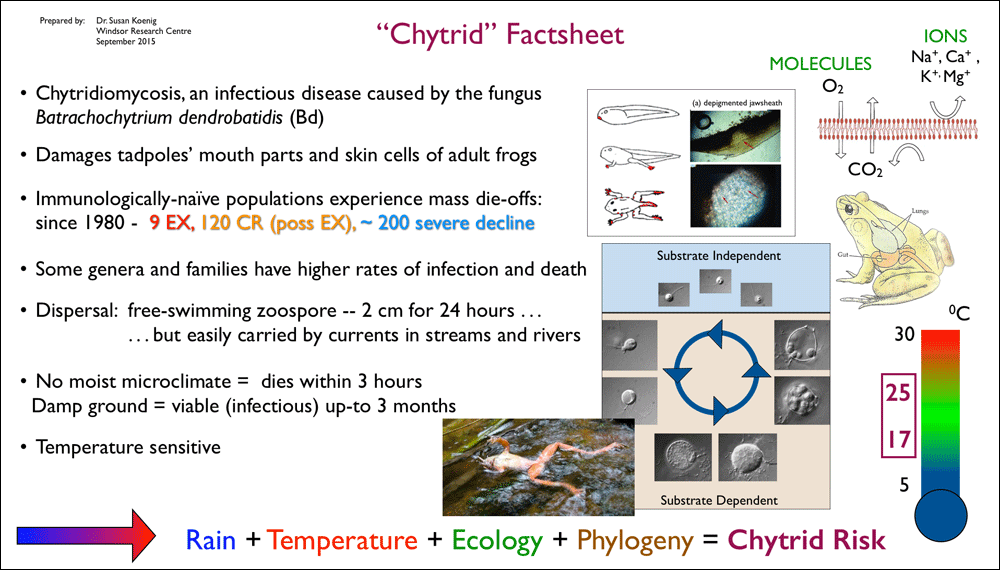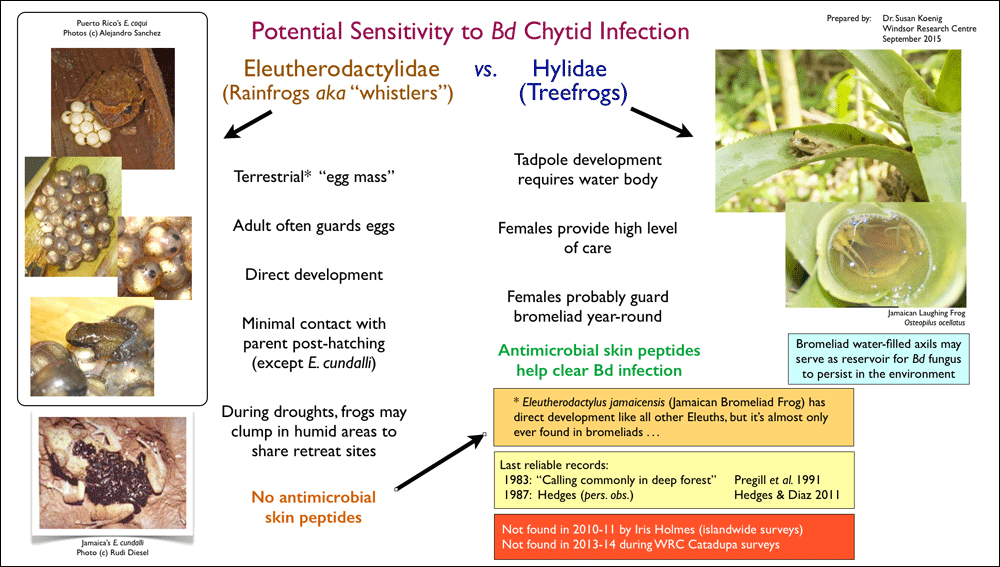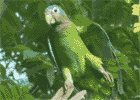Summary prepared by Dr. Susan Koenig, Windsor Research Centre, Jamaica.
According to the IUCN RedList, nearly 1/3 of the World's 5,532 anurans (frogs & toads) are threatened with extinction. Since the early 1980s, 9 species have gone extinct (EX) and 120 are "critically endangered, possibly extinct" (CR-poss EX). Most of these catastrophic declines are due to an infectious fungus, Batrachochytrium dendrobatidis (Bd), which causes Chytridiomycosis ("Chytrid" for short). Although the species of fungus was first described in 1999, it is not clear whether the current global pandemic is caused by a recently emerged clone or by a fungus which has been present for at least 1000 years but which has become "hot" for poorly understood environmental reasons. (See references in Talley et al. 2015.)
In tadpoles, Bd infects mouth parts, with the consequent damage affecting the ability to feed and grow properly. In adult frogs, Bd colonizes skin cells. Thickening and sloughing of skin sometimes will be seen at the "friction points" - the underside of feet and the inner thighs. But more often than not, infected frogs look healthy and we can only detect the presence of the fungus with laboratory tests.
When the number of fungal spores gets too high on a frog's normally-porous skin, the frog can't breathe, hydrate, osmoregulate (maintain salt balance), or thermoregulate: the frog dies of cardiac arrest. Immunologically-naive populations, those which have not been exposed previously to chytrid spores, are highly vulnerable -- mass die-offs occur, populations decline quickly, and if the population is small or isolated, extinction can occur.
As a recognized emerging infectious disease, in May 2008 the World Organization of Animal Health (OIE) declared infections with Bd (and ranavirus -- another threat to amphibians) as 'notifiable diseases', resulting in international recommendations to reduce further spread via human activities, particularly commercial trade. Jamaica is a member of OIE.
Chytrid spores, like frogs, need moisture: if the spores are removed from a moist microclimate, they will die within 3 hours; if the spores remain in a stream or moist soil, they can live to infect a frog for up-to 3 months. The spores tolerate ambient temperatures from 4-28 C, but the optimum is 17-25 C . . . so unfortunately, Jamaica offers an ideal climate for this foreign disease.
In Jamaica, experts think at least one endemic frog, the Jamaican Stream Frog (Eleutherodactylus orcutti), which was restricted entirely to the Blue Mountains, has gone extinct from chytrid. After conducting surveys in Catadupa, Windsor Research Centre (WRC) also shares the concern of Holmes et al. (2012) for Jamaica's second semi-aquatic Eleuth, the Jamaican Bromeliad Frog (Eleutherodactylus jamaicensis): we, too, failed to confirm its presence during our surveys. Although several individuals of Eleutherodactylus were collected from bromeliad leaves, photographs revealed that they were NOT E. jamaicensis. Two factors raise the "red flag of concern" for this species: (1) frogs in the family Eleutherodactylidae show a higher sensitivity to chytrid fungus than many other anuran families; and (b) the Jamaican Bromeliad Frog's special ecology.
Below are two slides which WRC's Dr. Susan Koenig created for a Keynote presentation, which give a brief overview of "chytrid" and the reason why we think the Jamaican Bromeliad Frog is at great risk of being exposed to and dying from chytrid compared to other species in the family Eleutherodactylidae or for species in Jamaica's other frog family called Hylidae.
For the results of WRC's chytrid surveys in the Catadupa KBA, click here
See also our Chytrid Newsletter, "Catadupa Frogs, Singin' In The Rain"
There is considerable information about chytrid on the web.
A good start to keeping up-to-date on the disease and on the status of global frog populations is to
follow "FrogLog", the newsletter of the IUCN Amphibian Specialist Group and the Amphibian Survival Alliance.
Issue 113 (Winter 2015)
is a Special Edition for Amphibian Diseases & Disease Mitigation Techniques.


Acknowledgements:
Funding for Catadupa chytrid surveys and preparation of Keynote slides was provided by:
 |
Technical References
Boyle, D.G., D.B. Boyle, V. Olsen, J.A.T. Morgan. and A.D. Hyatt. 2004. Rapid quantitative detecctoin of chytridiomycosis Batrachochytrium dendrobatidis in amphibian samples using real-time Taqman PCR assay. Diseases of Aquatic Organisms 60: 141-148.
Hedges, S.B. and L.M. Diaz. 2011. The conservation status of amphibians in the West Indies. Pp. 31-47 In A.Hailey, B. Wilson, and J. Horrocks (eds.) Conservation of Caribbean Island Herpetofaunas Volume 1: Conservation Biology and the Wider Caribbean. Brill, Leiden, The Netherlands.
Holmes, I., K. McLaren, and B. Wilson. 2012. Surveys for frog diversity and Batrachochytrium dendrobatidis in Jamaica. Herpetological Review 43: 278-282.
Longcore J.E., A.P. Pessier, and D.K. Nichols. 1999. Batrachochytrium dendrobatidis gen. et sp. nov., a chytrid pathogenic to amphibians. Mycologia 91: 219-27.
Olson, D.H., D.M Aanessen, K.L. Ronnenberg, C.I. Powell, S.F. Walker, J. Bielby, T.W.J. Garner, G. Weaver, The Bd Mapping Group, and M.C. Fisher. 2013. Mapping the global emergence of Batrachochytrium dendrobatidis, the amphibian chytrid fungus. PLoS ONE 8(2): e56802. doi:10.1371/journal.pone.0056802
Piotrowski, J.S., S.L. Annis, and J.E. Longcore. 2004. Physiology of Batrachochytrium dendrobatidis, a chytrid pathogen of amphibians. Mycologia 96: 9-15.
Pregill, G.K., R.I. Crombie, D.W. Steadman, L.K. Gordon, F.W. Davis, and W.B. Gartner. 1991. Living and Late Holocene fossil vertebrates, and the vegetation of the Cockpit Country, Jamaica. Atoll Research Bulletin No. 353. Issued by National Museum of Natural History, Smithsonian Institution, Washington, D.C.
Rollins-Smith, L.A., J.P. Ramsey, J.D. Pask, L.K Reinert and D.C. Woodhams. 2011. Amphibian immune defenses against Chytridiomycosis: impacts of changing environments. Integrative and Comparative Biology (2011): doi:10.1093/icb/icr095
Talley, B.I., C.R. Muletz, V.T. Vredenburg, R.C. Fleischer, and K.R. Lips. 2015. A century of Batrachochytrium dendrobatidis in Illinois amphibians (1888-1989). Biological Conservation 182: 254-261. doi:10.1016/j.biocon.2014.12.007:

